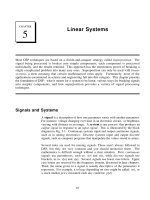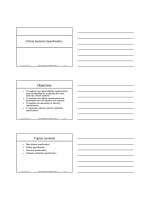Critical Systems Validation
Bạn đang xem bản rút gọn của tài liệu. Xem và tải ngay bản đầy đủ của tài liệu tại đây (118.16 KB, 15 trang )
©Ian Sommerville 2004 Software Engineering, 7th edition. Chapter 24 Slide 1
Critical Systems Validation
©Ian Sommerville 2004 Software Engineering, 7th edition. Chapter 24 Slide 2
Objectives
To explain how system reliability can be
measured and how reliability growth models
can be used for reliability prediction
To describe safety arguments and how these
are used
To discuss the problems of safety assurance
To introduce safety cases and how these are
used in safety validation
©Ian Sommerville 2004 Software Engineering, 7th edition. Chapter 24 Slide 3
Topics covered
Reliability validation
Safety assurance
Security assessment
Safety and dependability cases
©Ian Sommerville 2004 Software Engineering, 7th edition. Chapter 24 Slide 4
Validation of critical systems
The verification and validation costs for critical
systems involves additional validation processes
and analysis than for non-critical systems:
• The costs and consequences of failure are high so it is
cheaper to find and remove faults than to pay for system
failure;
• You may have to make a formal case to customers or to a
regulator that the system meets its dependability
requirements. This dependability case may require
specific V & V activities to be carried out.
©Ian Sommerville 2004 Software Engineering, 7th edition. Chapter 24 Slide 5
Validation costs
Because of the additional activities involved,
the validation costs for critical systems are
usually significantly higher than for non-
critical systems.
Normally, V & V costs take up more than
50% of the total system development costs.
©Ian Sommerville 2004 Software Engineering, 7th edition. Chapter 24 Slide 6
Reliability validation
Reliability validation involves exercising the program
to assess whether or not it has reached the required
level of reliability.
This cannot normally be included as part of a normal
defect testing process because data for defect
testing is (usually) atypical of actual usage data.
Reliability measurement therefore requires a
specially designed data set that replicates the
pattern of inputs to be processed by the system.
©Ian Sommerville 2004 Software Engineering, 7th edition. Chapter 24 Slide 7
The reliability measurement process
Compute
observed
reliability
Apply tests to
system
Prepare test
data set
Identify
operational
profiles
©Ian Sommerville 2004 Software Engineering, 7th edition. Chapter 24 Slide 8
Reliability validation activities
Establish the operational profile for the
system.
Construct test data reflecting the operational
profile.
Test the system and observe the number of
failures and the times of these failures.
Compute the reliability after a statistically
significant number of failures have been
observed.
©Ian Sommerville 2004 Software Engineering, 7th edition. Chapter 24 Slide 9
Statistical testing
Testing software for reliability rather than fault
detection.
Measuring the number of errors allows the reliability
of the software to be predicted. Note that, for
statistical reasons, more errors than are allowed for
in the reliability specification must be induced.
An acceptable level of reliability should be
specified and the software tested and amended until
that level of reliability is reached.
©Ian Sommerville 2004 Software Engineering, 7th edition. Chapter 24 Slide 10
Reliability measurement problems
Operational profile uncertainty
• The operational profile may not be an accurate
reflection of the real use of the system.
High costs of test data generation
• Costs can be very high if the test data for the
system cannot be generated automatically.
Statistical uncertainty
• You need a statistically significant number of
failures to compute the reliability but highly
reliable systems will rarely fail.
©Ian Sommerville 2004 Software Engineering, 7th edition. Chapter 24 Slide 11
Operational profiles
An operational profile is a set of test data whose
frequency matches the actual frequency of these
inputs from ‘normal’ usage of the system. A close
match with actual usage is necessary otherwise the
measured reliability will not be reflected in the actual
usage of the system.
It can be generated from real data collected from an
existing system or (more often) depends on
assumptions made about the pattern of usage of a
system.
©Ian Sommerville 2004 Software Engineering, 7th edition. Chapter 24 Slide 12
An operational profile
...
Number of
inputs
Input classes
©Ian Sommerville 2004 Software Engineering, 7th edition. Chapter 24 Slide 13
Operational profile generation
Should be generated automatically
whenever possible.
Automatic profile generation is difficult for
interactive systems.
May be straightforward for ‘normal’ inputs
but it is difficult to predict ‘unlikely’ inputs and
to create test data for them.
©Ian Sommerville 2004 Software Engineering, 7th edition. Chapter 24 Slide 14
Reliability prediction
A reliability growth model is a mathematical model of
the system reliability change as it is tested and faults
are removed.
It is used as a means of reliability prediction by
extrapolating from current data
• Simplifies test planning and customer negotiations.
• You can predict when testing will be completed and
demonstrate to customers whether or not the reliability
growth will ever be achieved.
Prediction depends on the use of statistical testing to
measure the reliability of a system version.
©Ian Sommerville 2004 Software Engineering, 7th edition. Chapter 24 Slide 15
Equal-step reliability growth
Reliability
(ROCOF)
t1 t2 t3 t4 t5
Time
©Ian Sommerville 2004 Software Engineering, 7th edition. Chapter 24 Slide 16
Observed reliability growth
The equal-step growth model is simple but it does
not normally reflect reality.
Reliability does not necessarily increase with change
as the change can introduce new faults.
The rate of reliability growth tends to slow down with
time as frequently occurring faults are discovered
and removed from the software.
A random-growth model where reliability changes
fluctuate may be a more accurate reflection of real
changes to reliability.
©Ian Sommerville 2004 Software Engineering, 7th edition. Chapter 24 Slide 17
Random-step reliability growth
t1 t2 t3 t4 t5
Time
Note dif ferent r elia bility
improvements
Fault r epair ad ds ne w fault
and decreases reliability
(increases ROC OF)
Reliability
(ROCOF)
©Ian Sommerville 2004 Software Engineering, 7th edition. Chapter 24 Slide 18
Growth model selection
Many different reliability growth models have
been proposed.
There is no universally applicable growth
model.
Reliability should be measured and observed
data should be fitted to several models.
The best-fit model can then be used for
reliability prediction.









